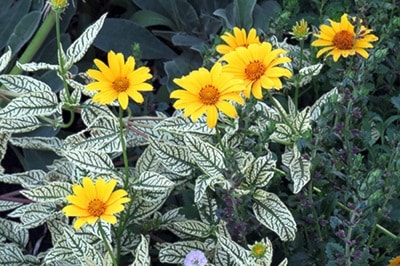There is nothing that yells “summer in the garden” better than sunny-faced flowers, in my opinion. So, I just have to rave about our false sunflower, Heliopsis helanthoides ‘Helhan’. (Also known as Heliopsis Loraine Sunshine.)
This special cultivar of a native North American perennial has been in full bloom in our garden since early June.
What sets it apart? Brilliant yellow, daisy-like flowers atop delightfully variegated leaves. Best of all, this plant will bloom straight through until frost which is a huge attractant for bees and butterflies.
And fuss-free! No diseases seem to bother this plant, and the only purported problem pest is aphids. However, I have not noticed any aphid problem in the five years, or so, since we added ‘Helhan’ to our garden inventory. This 30-inch (75 cm) tall, 18-24-inch (45-60 cm) wide, clump-forming plant has been a real stellar performer.
What more can a gardener ask for?
Well, for one thing, I wish the fall webworms would leave our pear tree alone! Just spotted a nest, which John has cut out, leaves included, and put in the garbage. Will have to keep a watchful eye for any others that may appear.
Do not be fooled by the common name of this pest. They have been active since late May or early June when the adult moths emerged from their pupae, where they had been over-wintering. Egg-laying on host plants, like our pear tree, began shortly after emergence.
Once the larvae hatch, they form colonies and begin feasting on the leaves. The formation of the webbing actually begins shortly after the onset of feeding. It is enlarged as the larvae grow and require more food, eventually becoming multi-layered and dense-looking.
This is the very clue which helped me to pinpoint that we have the orange-race of fall webworm, (Hyphantria cunea).
Now typically, this pest will not kill its host tree. However, their webs can be unsightly and fruit production can be seriously impacted if the tree is covered in web tents. Defoliation means photosynthesis is endangered.
For more information about this pest, visit my website at duchessofdirt.ca.
Leslie Cox co-owns Growing Concern Cottage Garden in Black Creek. Her website is at www.duchessofdirt.ca and her column appears every second Thursday in The Record
